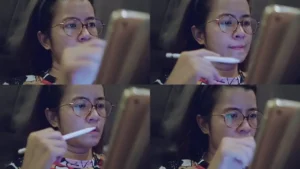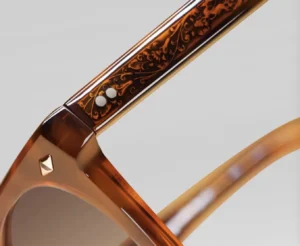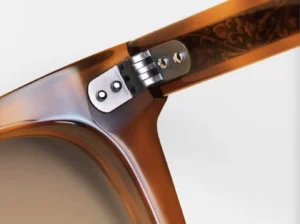Behind every stylish, fashionable pair of glasses produced by our Sunglasses Manufacturers is a team of talented designers conceptualizing fresh, inspired looks season after season. Heading up creative direction is Chris Klein, our Head Frame Designer for over 7 years.

Chris’s unique background blending optical science and artistic intuition makes her invaluable in leading our design division. Her expertise in frame styling, color theory, and trend analysis brings bold new aesthetics that continue pushing eyewear fashion forward.

We sit down with Chris to gain insider insight into her creative process of developing stylish, cutting-edge designs coveted by brands and consumers worldwide.
And discuss how to design sunglasses, and how to build your own eyewear brand.
1. Early Inspiration and Training in Glasses Designing
To start, what first drew you into the field of eyewear design? Were there any initial inspirations that sparked your interest?
I’ve always had a creative spirit and passion for design from a young age. Some early inspirations for me were architecture and automotive design. I loved sleek, sculptural shapes and forward-thinking aesthetics.
In college, I pursued industrial design and took electives on product development. An optical engineering course where we studied the physics of lenses fascinated me—it was intriguing to learn how eyewear marries aesthetics, science, and functionality.

My professor noticed my interest and suggested I explore frames. I began researching brands, shadowing designers at trade shows, and learning about materials and processes. I was hooked! The mix of fashion and technical complexity in optical design appealed to my dual interests.
2. Formal Education and Training in Designing Sunglasses
What formal education and training prepared you for a design career in eyewear?
My industrial design studies taught me foundational 3D modeling, prototyping, and manufacturing principles. But my optical engineering and anatomy courses provided specialized knowledge on designing eyewear that accounts for fit, weight, vision correction, and other technical factors.

I also attended Silmo trade shows in Paris to analyze market trends and connect with industry veterans. Their feedback and critiques on my student designs were invaluable for my growth. I spent a summer interning at a small frame manufacturer to learn hands-on techniques.
Once I completed my Master’s in Industrial Design, I pursued dedicated eyewear design certifications. This covered specialized topics like ophthalmic standards, ergonomics, materials selection, and fabrication methods. These equipped me with well-rounded technical and creative skills tailored to frames.
3. Joining Our Eyewear Company
What led you to join our sunglasses manufacturing company as Head Frame Designer?
Throughout my training, I was impressed by the technical expertise and culture of innovation here. The state-of-the-art prototyping lab, access to global materials and suppliers, and opportunities to collaborate with our engineering teams appealed to me.

Most importantly, the emphasis on constant creativity and pushing boundaries matched my ethos as a designer. I wanted to join a progressive company where I could really elevate eyewear aesthetics and bring unconventional ideas to life. The chance to lead design for brands worldwide was an exciting challenge!

Seven years later, I’m still stimulated and inspired daily by our team. We’ve accomplished a lot, but there’s always new creative ground to break.
4. Design Glasses Process and Inspiration
Walk us through your typical design process. Where do you draw inspiration from?
The process always starts by analyzing the latest market and consumer trends—I study fashion runways, boutique brands, street styles, and more. I also meet with our sales teams to understand what styles and features customers are demanding.

With this context, I start sketching and brainstorming shape and material concepts. Sometimes I’ll be inspired by architecture, nature, or modern art. Other times, I’ll focus on a specific goal, like reinventing a classic frame style for today’s market.

After initial ideas are formed, I start 3D modeling the best ones digitally. This lets me iterate and experiment with shapes, proportions, colors, and material mixes quickly. As concepts solidify, I coordinate physical prototyping. We have state-of-the-art 3D printing and CNC machining to produce samples and test fit.
Finally, the best design options are presented to our sales and marketing teams, and then to customers. Their feedback helps refine and finalize the best-performing concept before proceeding to manufacturing.
5. Trend Analysis and Forecasting
As a designer, how do you stay ahead of the latest eyewear trends and predict what’s next?
I make a point to constantly analyze styles across industries—not just fashion, but furniture, automotive, architecture, and more. I look for patterns, material preferences, and new manufacturing capabilities. By understanding macro trends, I can forecast how they could manifest in optical.

Traveling is hugely important for perspective too. I visit design hubs like Tokyo, Milan, and Paris often. Experiencing fresh aesthetics and lifestyles in different cultures inspires me to push boundaries. Trade shows like Silmo let me network with fellow designers to discuss ideas.
Customer feedback provides valuable insight into gaps in the market and demand shifts. I talk to sales teams often and survey opticians worldwide. Combining all these inputs helps me accurately anticipate trends 12-18 months in advance. It’s about staying curious.
6. Notable Sunglasses Designs and Achievements
Can you share some of your proudest eyewear designs or achievements so far?
One recent design I’m really proud of is the Adele half-rim cat eye frame. It modernizes a retro shape with its assertive angles but gives it a contemporary edge in titanium. The fine double bridge detail adds sophistication. It perfectly balances nostalgia and forward-thinking.

The Wright aviator frame also stands out for its slender metal shape inspired by vintage riveted styles. We re-engineered it with advanced titanium alloys and a pleasingly lightweight feel. The combination of heritage and innovation resonated really well with consumers.
On the technology side, I’m proud of helping implement 3D printing and new parametric design tools into our workflow. This opened up shapes and customization possibilities we couldn’t achieve before. Seeing these technologies expand creative boundaries continues to excite me!
7. Biggest Challenges in Designing Sunglasses
What are some of the biggest challenges you face as an eyewear designer? How do you overcome them?
One of the biggest challenges is balancing creativity with technical and commercial viability. Sometimes I have an unconventional design concept that I love, but manufacturing it is limited by cost or technology constraints.
Other times, the sales team voices concerns that very futuristic designs may intimidate consumers and hurt adoption. Finding the right balance pushes me to get creative.
I’ve learned not to become too attached to any single design too early. Instead, I keep innovating and presenting options until we reach that harmonious merger of creative daring and commercial success. Having an open, collaborative environment here has empowered me to push past limitations.
8. Future Vision and Goals in Designing Sunglasses
Looking ahead, what are your vision and goals for the future of our eyewear design?
I’m really excited to continue pioneering 3D printing, sustainable materials, and smart tech integration to push eyewear innovation further. I foresee huge potential in customization – using body scans for made-to-measure frames tailored to an individual’s biomechanics.

AR and digital try-on tech can revolutionize the customer experience and product development cycle. I’d also love to explore biometric tracking and other functionalities through connected eyewear.
Most importantly, my goal is to keep delighting customers with fresh looks and comfortable, lightweight frames full of personality. Our ability to turn concepts into physical products rapidly through advanced prototyping empowers me to make that vision a reality.
9. Conclusion
We’re grateful to Chris for sharing insider views into her creative process and achievements leading frame design. Her visionary outlook combined with her strong technical aptitude has been invaluable in progressing our brand. Joanna’s passion for innovating and elevating eyewear continues to motivate our entire team. We eagerly anticipate the next generation of designs under her talented direction.



